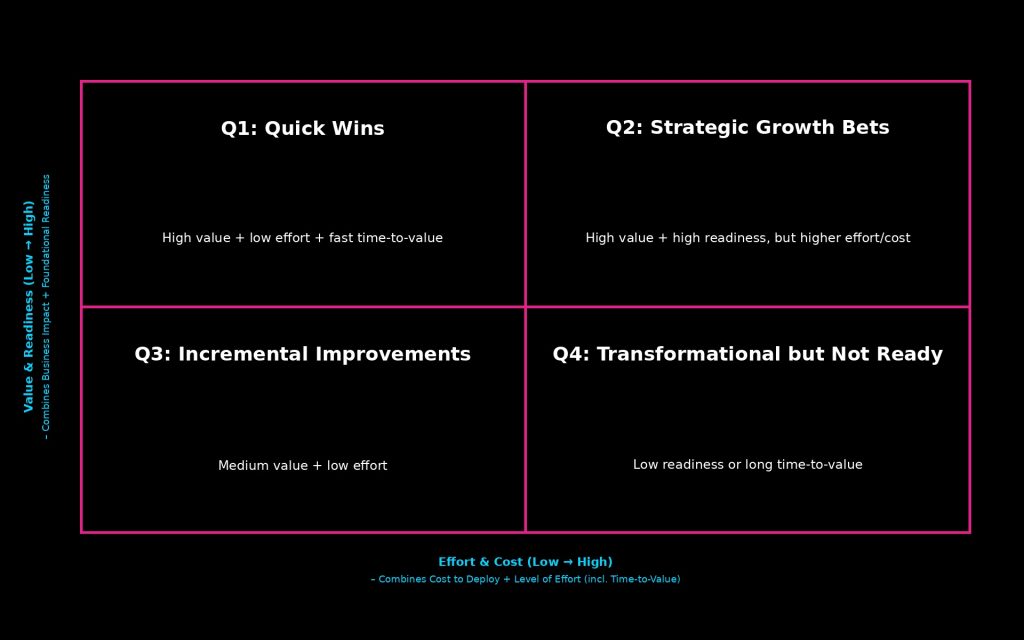Articles
How to develop your AI strategy

Every organisation is under pressure to “have an AI strategy” from investors asking about competitiveness, employees wondering how AI will reshape their roles, customers expecting smarter experiences, and boards wanting clarity on risk. Even if a company is not ready to deploy advanced AI, it still needs a thoughtful point of view: Where can AI create value? How will we use it responsibly? What foundations must be in place?
A small sidebar: I believe in a few years, companies won’t produce standalone “AI strategies” at all. Just as “digital transformation” became embedded into every business plan, AI will soon be part of every strategy and operating model. But today, with the pace of change accelerating, organisations still need clarity.
Why AI matters
Several shifts in consumer behaviour and business performance show how fast AI is being adopted:
- 50% of consumers already use AI-powered search when looking for products.
- 73% identify as omnichannel shoppers, expecting seamless “phygital” experiences.
- AI in e-commerce is delivering 25%+ improvements across customer satisfaction, revenue uplift, or cost reduction.
The value is clear. The challenge is knowing where to start.
AI clearly matters but what do we actually mean by “AI”? The term covers a wide range of capabilities, from basic statistical models to fully autonomous agents. Understanding this evolution is essential because the right starting point depends on your business priorities, your data maturity and your technical capabilities. Before deciding where to focus, it helps to look at how AI has evolved and which types of AI you may want to consider for your organisation.
How AI has evolved and what that means for your strategy
Understanding the evolution of AI helps leaders see where their organisation currently sits, and what each stage requires to deliver value.
The 1st Era: Manual insights (c. 1900 onwards)
The earliest form of intelligence in business was statistical inference. Organisations manually analysed data using techniques like t-distributions to estimate a mean or identify patterns.
What it enabled: data-driven decisions.
What it required: structured data and analysts.
The 2nd Era: Advanced analytics (1940–2020)
Artificial Intelligence and Machine Learning introduced predictive capabilities.
Typical use cases:
- Customer segmentation
- Predicting footfall or demand
- Product recommendations
What it enabled: accurate forecasting and smarter decisions.
What it required: integrated datasets, ML models and operational processes.
The 3rd Era: Generative AI (2021–2024)
Generative AI and Large Language Models brought human-like text and content generation.
Examples include:
- Creating marketing content
- Running simple support chatbots
- Automating internal tasks such as code generation
What it enabled: large productivity gains.
What it required: models, prompt design and governance.
The 4th Era: Agentic AI (2024+)
We are now moving into autonomous, goal-driven agents, powered by technologies such as MCP, ACP servers and Agent-to-Agent (A2A) collaboration. Examples already emerging:
- A customer chatbot that can orchestrate commerce actions such as cancelling or returning an order
- A customer placing and paying for an order with a specific merchant directly through ChatGPT
What it enables: end-to-end process automation and autonomous execution.
What it requires: real-time data, integrated systems, orchestrated workflows and strong governance.
What a strong AI foundation looks like
Before deploying any of the above, organisations need the fundamentals that allow AI to perceive, decide and act:
- Integrated systems with automated data flows
- Single view of data, e.g., customer, product, sales
- Event-level, real-time data
- Orchestrated workflows AI can augment or automate
- Analytics capabilities to measure and interpret impact
But technology is only one component. During a recent webinar we co-hosted with Deloitte Digital, we highlighted that AI success depends on five key organisational pillars: strategic ambition and alignment, operational integration, organisational and cultural change, governance and value realisation, and a strong data and technical foundation. Together, these ensure AI is embedded responsibly, measurably and at scale.
To help you develop an AI strategy that is practical, value-focused and aligned to your organisation’s readiness, we’ve outlined a four-step approach. It starts with building on what you already have, focuses on quick wins, and then guides you toward more advanced capabilities such as Agentic AI, all while ensuring strong governance and measurable outcomes.
A four-step approach to developing an AI strategy
1. Build on the foundation
Connect and elevate existing investments to support AI.
Outcome: Faster, safer and more cost-effective deployment.
2. Deliver quick wins
Start small and prioritise use cases that fit current data readiness:
- Insights & analytics
- Predictive intelligence
- Action-oriented automation
Outcome: Immediate value and organisational confidence.
3. Move toward Agentic AI
When workflows are integrated and automated, evolve toward agents that act, not just analyse.
Outcome: Faster processes, lower cost and continuous optimisation.
4. Govern, measure and scale
Put in place the guardrails and capabilities needed for sustained success.
Outcome: AI stays aligned to business goals and accountable to value.
Use a framework to select your AI use cases
To support your AI strategy, we have also provided a simple tool to help you prioritise AI use cases. It guides you toward the opportunities that will create the most value, based on your readiness, cost, effort and time-to-value. This ensures your roadmap is grounded in reality – not hype – and helps you sequence initiatives in a way that delivers quick wins while building toward more transformative outcomes.

The message is: Start small. Deliver value quickly. Scale what works. Build the foundations along the way.
If you’re looking to accelerate your AI journey, whether by identifying quick-win use cases, assessing your data and technology foundation, or designing an enterprise-wide AI roadmap, we’d be happy to help. Our team works with organisations to turn AI vision into measurable business value, and we can support you at any stage of the journey.
Get in touch if you’d like to explore what this could look like for your organisation.
Author
Lance Mercereau
Chief Marketing Officer

Recent posts
- How to develop your AI strategy
- The Future of Commerce: Why winning with AI starts with trusted data
- Xiatech and Pimberly announce partnership to help organisations unlock the full value of their product data
- Xiatech achieves ISO 27001 recertification focused on information security
- On-demand webinar: How to Get Your Company AI-Ready
Subscribe to The Hyper-Insights Newsletter
Discover the benefits of a Hyper-connected business with infinite possibilities. Bringing the latest news and tips to your inbox from our expert team.





